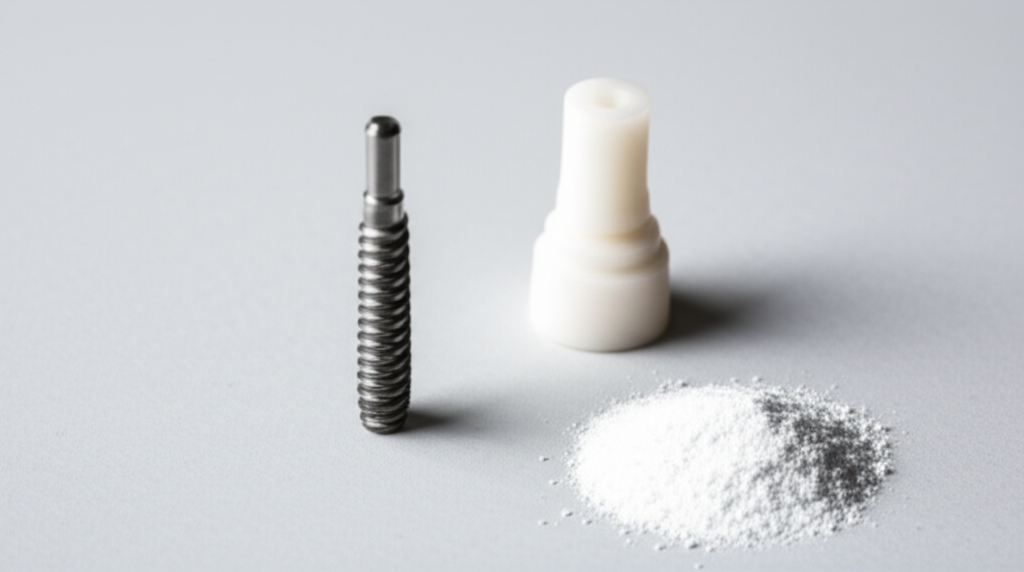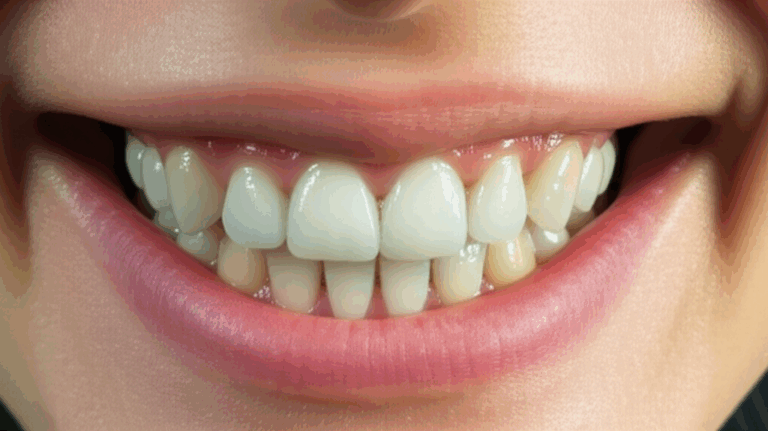
What Are Dental Implants Made Of? A Simple Guide to Materials and Your Health
Have you ever wondered what’s really inside your dental implant? Or do you worry what happens when something “fake” goes into your mouth—right in your jawbone? If so, you’re not alone. In this article, I’ll explain what dental implants are made of in plain, simple words, tell you what makes some implants better, and help you figure out how to pick the best one for you. This is worth reading, because knowing what’s inside your mouth helps you make smart, safe choices—especially for something as important as your teeth.
Table of Contents
What Is a Dental Implant?
Let’s start super simple. A dental implant is a small post that goes into your jaw to replace a missing tooth’s root. It holds a new fake tooth (the crown) on top. It sounds fancy, but the idea is easy: give you a tooth that feels like your real tooth. Implants have changed people’s smiles and confidence everywhere.
A long time ago, if you lost a tooth, you had to live with a gap or a big denture. Now, thanks to smart people like Per-Ingvar Brånemark, we have implants made from tough, safe stuff.
The Three Main Parts of a Dental Implant
Every dental implant has three main pieces:
This is the screw that goes into your jawbone. It holds everything in place.
This part sticks up past your gums. It connects the post to the fake tooth.
This is the part you see—it looks and works like a real tooth.
Why does this matter? Because each part can be made from different stuff, and that changes how the whole thing feels, looks, and lasts.
What Materials Are Used for the Implant Post?
Most dental implant posts are made from titanium or zirconia. Let’s check both:
Table: Common Implant Post Materials
| Material | What Is It? | Safe? | Color | Used Since |
|---|---|---|---|---|
| Titanium | A strong metal | Yes | Silver/grey | 1960s |
| Zirconia | A hard ceramic | Yes | Tooth-white | 2000s |
Titanium and zirconia are the main choices because they are both friendly to your body—which means your body accepts them. They also have the right mix of strength, safety, and price.
Titanium Implants: The Gold Standard
If you ask most dentists or implant dental laboratory people, they’ll say titanium is the solid choice. Here’s why:
- Really strong but not heavy. Titanium is super strong but light. It handles tough chewing easily.
- Long history. Dentists have used it for over 50 years.
- It joins with your bone. Something called osseointegration happens, which means your bone grows and sticks to the implant, making it stable for a very long time.
- Doesn’t rust. It doesn’t break down in your mouth.
- Very safe. Hardly anyone is sensitive to it.
But titanium isn’t perfect. You might sometimes see a bit of gray color at your gum if your gums are thin—especially when you laugh big. Very rarely, some people might worry about a metal allergy or want no metal at all.
Types of Titanium Used
- Grade 4 Titanium: Almost pure, really tough.
- Grade 5 Titanium (Ti-6Al-4V alloy): Has a little aluminum and vanadium for extra toughness.
Easy Example
Titanium is kind of like a product that lasts forever and works for everybody. That’s why people trust it for implants.
Zirconia Implants: The Metal-Free Option
But what if you don’t want any metal in your mouth? Then zirconia implants are for you. Here’s what makes them good:
- They look like teeth. Zirconia is naturally white (really it’s zirconium dioxide), so it matches your smile.
- No metal allergy worries. It’s all ceramic—no metal at all.
- Easy on your gums. Bacteria doesn’t stick as much, which might help your gums.
- Strong, but… Even though it’s strong, zirconia can be more likely to crack if hit really hard.
The One-Piece Kind
Most zirconia implants are made as one piece—post and connector together. This can help avoid small gaps where germs hide. But, it means they have to be put in just right the first try.
Real Example
Straumann PURE Ceramic Implant and other big-name brands show zirconia implants can work well for years. New research gets better every year.
What Materials Are Used for Abutments?
The abutment connects your fake tooth to the implant post. Most abutments are made from:
- Titanium: Strong and usually used with titanium posts.
- Zirconia: Looks better if you use a ceramic crown.
- Gold Alloy: Sometimes used for old-fashioned strength and shine.
- PEEK: A special plastic, sometimes used for special cases.
The abutment is sort of like the “frame” in a house—it keeps your “roof” (the crown) steady on the “foundation” (the post).
What Materials Make the Dental Crown?
The dental crown is what you see and chew with—so it needs to look and work just right. Crowns are made from:
| Material | Looks Natural? | Strong? | Used For |
|---|---|---|---|
| Porcelain | Yes | Good | Most common |
| Zirconia | Yes | Very Strong | Front & back teeth |
| Porcelain-Fused-to-Metal (PFM) | Yes | Very Strong | Bridges, big cheeks |
| E.max (Lithium disilicate ceramic) | Yes | Very Good | Smile teeth |
- Porcelain crowns look just like real teeth.
- Zirconia crowns are super tough, don’t chip much, good for heavy biters.
- E.max crowns are strong and pretty.
- PFM crowns are old favorites: metal inside, covered with porcelain on the outside.
Now, many crowns are made using CAD/CAM digital dental lab tech so they fit perfectly. You can learn more about high-quality crowns at our crown and bridge lab.
Are Dental Implants Safe for Everyone?
Here’s the good news: both titanium and zirconia are safe for almost everyone.
Allergies and Reactions
- Allergies to titanium are super rare—less than 1%.
- Zirconia is metal-free and almost never an allergy problem.
If you’re worried about allergies, you can talk to your dentist. Some people even get tested before their surgery.
MRI Safety
Both titanium and zirconia are usually safe for MRI scans. Titanium isn’t magnetic, zirconia is ceramic, and you won’t set off metal detectors at airports either!
How Long Do Dental Implants Last?
Let’s be honest—nobody wants a tooth that breaks after a few years.
How Many Years Can You Get?
Most titanium implants last 15–20 years or more. Some last a lifetime! Studies show success rates of 95–98% over ten years.
Zirconia implants haven’t been used as long, but early results are good—92–97% still working after 5–7 years, and new studies look promising.
It really depends on:
- How well you brush and floss!
- How good your dentist is
- Where the implant goes (back teeth do more work)
- Your health (healthy gums and bone help a lot)
How Can You Choose the Best Implants for You?
Let’s talk about your choices:
Problem
You want a dental implant that looks and feels great, lasts a long time, and won’t give you health problems. But which type should you pick?
What Makes This Hard
With all the options, choosing can make your head spin. Do you want titanium because it’s trusted? Or zirconia to stay away from any metal showing? Should you worry about allergies? What about an MRI next year? All this makes it tricky.
Your Solution
Good news—you don’t have to pick alone. Your dentist and a good dental lab will talk about:
- Your health: Allergies, sensitivities, other surgeries.
- Your gums and bones: Healthy gums and bone make implants stronger.
- Where it goes: If it’s in front, you probably want it to look really natural. For back teeth, strength matters more.
- Your smile goals: Everyone wants teeth that look real!
- Your budget: Some materials cost more—your dentist can help you find what works for you.
If you want more details about different materials, just ask those who keep up with the latest tech, or check out a digital dental lab for new options.
Common Questions About Dental Implant Materials
1. Can anyone get zirconia implants instead of titanium?
Almost everyone can, especially if you want no metal at all. But in some cases, titanium might be better, like if your bone is thin.
2. Do dental implants ever cause allergies?
Titanium allergies are super rare. Zirconia doesn’t cause allergies. Just tell your dentist about your medical history, just in case.
3. Is one better for the front teeth than the back?
Zirconia is good for front teeth where you want it to blend in. Titanium is often used in back teeth because it’s super strong.
4. What about crowns, bridges, or full dentures?
Implants can hold all these! Ask your dentist or a dental ceramics lab to see what’s best for you.
5. Are there eco-friendly or new materials coming soon?
Scientists always look for new things. For now, titanium and zirconia are the most common and safest choices.
Key Points to Remember
- Dental implants are made of safe titanium or zirconia, with a crown on top.
- Titanium is tough, used for many years, and trusted by dentists.
- Zirconia is metal-free, white, and good if you’re really worried about allergies or want the best look.
- Crowns for implants are usually porcelain, zirconia, E.max, or PFM—to look great and fit well.
- Both main kinds are safe for MRI and very unlikely to cause allergies.
- Talk with your dentist and your dental lab for advice—don’t be shy about asking!
- With good care, your implant can last a really long time—sometimes forever.
Remember: Getting a dental implant is a big step for your health and your happiness. A little research—and talking with experts—can help your new smile last a lifetime!








